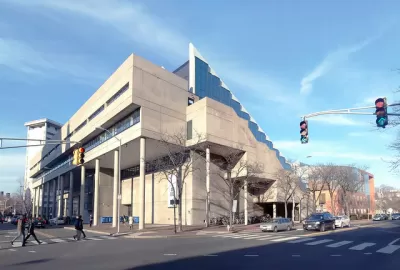Students investigating options often ask if it makes a difference where the planning school is located. The short answer is it matters less to students than many think.

For those wanting to enter graduate school in 2013, applications will soon be due. Students investigating options often ask if it makes a difference where the planning school is located-in a design school, a public policy college, or in other locations like colleges of agriculture or arts and sciences. The short answer is it matters less to students than many think.
Certainly there are some differences in some places. Planning programs in policy schools may require an extra quantitative methods class or two, some programs in design schools want an extra studio or project-based class, but there are many exceptions. In very small colleges with only two or three departments, administrators sometimes try to promote uniformity across programs in terms of curriculum. If the planning program is very small such requests can be hard to resist, particularly if other departments are large. But there is a great deal of self-governance among faculty. Further, even if there is a move for departments to have similarities it can be done through mechanisms such as conferences, joint competition entries, and other events that don't affect the main planning curriculum.
The Planning Accreditation Board makes the coursework and other requirements in accredited programs more uniform as well-about half a typical program is covering such material. Of course different departments do this in different ways but there is some consistency among accredited programs.
I think a bigger difference is between programs with small cores-where you have more chance to do electives and explore your own interests-and those with large cores where there is more of a uniform curriculum that all students go through. Both have strengths. I prefer small cores but understand the other perspective. To see if something is a small core see how many classes are really difficult to waive, and then how many other requirements there are. Small core programs tend to have 2-4 really-hard-to-waive classes and a core (excluding elective-heavy concentrations, internship requirements, exit project options, and the like) of under a year.
Another key difference, particularly relevant in small core programs, is the depth of urban and regional offerings across campus. Some planning programs are pretty much the only game in town in terms of urban and regional expertise on campus. In other universities there are many other departments where you might like to take classes and these may well be outside the college where the planning program is situated. Where a program is in a design school you will often find students crossing campus to public policy. If it is in an architecture school and landscape is in the agriculture college, then many planners find themselves in the ag school, and so on.
Dual degrees can give you a sense of the range of cross-campus connections. In some places there are lots of such connections and other places focus on the main planning degree. In addition, student groups--for example in international development, sustainability, or real estate--can show you how connected you might be within and outside the department.
The bottom line is to investigate programs individually. Faculty, particularly those who have served on curriculum committees and investigated other schools, may be well placed to give you advice. Not all faculty members have that expertise, however. You can do a lot of this yourself by comparing programs using online materials. The program you join, and the wider university that supports it, will matter more to you than the college or school it is part of.

Alabama: Trump Terminates Settlements for Black Communities Harmed By Raw Sewage
Trump deemed the landmark civil rights agreement “illegal DEI and environmental justice policy.”

Study: Maui’s Plan to Convert Vacation Rentals to Long-Term Housing Could Cause Nearly $1 Billion Economic Loss
The plan would reduce visitor accommodation by 25% resulting in 1,900 jobs lost.

Planetizen Federal Action Tracker
A weekly monitor of how Trump’s orders and actions are impacting planners and planning in America.

Waymo Gets Permission to Map SF’s Market Street
If allowed to operate on the traffic-restricted street, Waymo’s autonomous taxis would have a leg up over ride-hailing competitors — and counter the city’s efforts to grow bike and pedestrian on the thoroughfare.

Parklet Symposium Highlights the Success of Shared Spaces
Parklets got a boost during the Covid-19 pandemic, when the concept was translated to outdoor dining programs that offered restaurants a lifeline during the shutdown.

Federal Homelessness Agency Places Entire Staff on Leave
The U.S. Interagency Council on Homelessness is the only federal agency dedicated to preventing and ending homelessness.
Urban Design for Planners 1: Software Tools
This six-course series explores essential urban design concepts using open source software and equips planners with the tools they need to participate fully in the urban design process.
Planning for Universal Design
Learn the tools for implementing Universal Design in planning regulations.
Caltrans
Smith Gee Studio
Institute for Housing and Urban Development Studies (IHS)
City of Grandview
Harvard GSD Executive Education
Toledo-Lucas County Plan Commissions
Salt Lake City
NYU Wagner Graduate School of Public Service






























